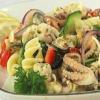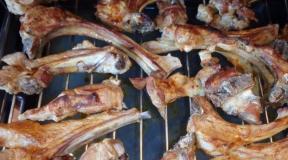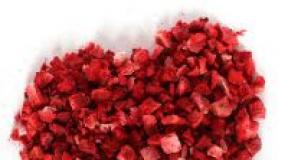Interesting facts about sushi (24 photos). Sushi
Twenty years ago, we associated Japan with animated cartoons, ninjas, samurai, kimonos, etc. Few people knew about the existence of Japanese cuisine. The customers of the first sushi restaurants were the Japanese themselves, who, by the will of fate, ended up in Russia in the early 90s.
Gradually, the fashion for them began to conquer the capital. Each of us can remember the moment when for the first time in his life he took chopsticks instead of a fork and tasted raw fish. And now we have chosen the best sushi in Moscow by comparing bars, restaurants and cafes.
Our selection of the best sushi is determined by the following:
- taste– only the best sushi can be called delicious;
- service- in the best institution "the client is always right", and if he is wrong, then this is not his problem;
- price- expensive does not mean quality at all, so we will select the best sushi in Moscow based on their affordability.
The most popular dishes on the menu of a bar or restaurant, without which no bill can do, are rolls and sushi. It is from them that we will begin to find out where the best sushi is cooked and served in the city. We determined taste and service empirically, i.e. having tried many different dishes in many different places.
Taste is a subjective concept, "there are no comrades." But the service can be unambiguously characterized by such data as: the speed of service, the behavior and attitude of staff towards guests, cleanliness and convenience.
The average score is an important criterion when choosing sushi. For some, it is important to eat tasty food on a small budget, while for others, a solid bill from the most expensive restaurant in Moscow becomes a reason for pride.
To determine the pricing policy of the selected places, the site team added up the prices from the menu and divided by the number of positions. As a result, we got the average cost of rolls for several restaurants. We applied the same formula to calculate the cost of sushi.
Price comparison of five restaurants
| Two sticks | Gin no Taki | Yakitoriya | Niyama | tanuki | |
| Wed cold roll price | 344 | 332 | 331 | 315 | 306 |
| Types of cold rolls | 23 | 25 | 37 | 39 | 45 |
| Wed price of warm rolls | 330 | 408 | 310 | 293 | 384 |
| Types of warm rolls | 7 | 9 | 10 | 9 | 8 |
| Wed sushi price | 98 | 110 | 100 | 89 | 99 |
| Types of sushi | 27 | 19 | 29 | 24 | 24 |
No. 5. Restaurant Two sticks

In the rating “Best Sushi in Moscow”, the chain “Two sticks” has moved from third place to fifth and, if it goes on like this, it will leave it altogether. The interior of the institution is made in urban style. The halls are equipped with monitors, which usually display online scoreboards of Moscow airports.
Japanese, Italian, Pan-Asian, American cuisines are presented here. Every year the quality and service of the institution are falling. The scenario of Two sticks is very similar to the fate of Yaposha. In the same way, the service first fell, and then the quality of the dishes.
By the way, Two Sticks, to put it mildly, has a terribly inconvenient site from all the participants in the rating. The developers tried their best to complicate the life of their customers. Perhaps this was done so that the user did not notice the extra charge on the delivery menu.
Service
If earlier a feature of Two Sticks could be called a strong difference in service in different establishments (there were places where the service and the attitude of waiters were at a very high level, and there were those where they would take an order only ten minutes after your arrival and bring the bill only fifteen minutes later as you requested). Now, most establishments are getting equally bad.
Taste
The quality and taste of dishes in most Two sticks on the same level is normal. We didn't find any dishes that taste so great that we would go to Two sticks for that, but these are normal, acceptable dishes. Gradually, the quality of the food also deteriorates.

Price
On the delivery menu, Two sticks made an extra charge of about 20-40 r, but delivery is free (although it is free for everyone). There are 23 types of cold rolls, 8 warm rolls and 27 sushi rolls. The average cost of cold rolls is 344 r, warm - 384. Cold rolls are the most expensive in the ranking. Sushi cost 98 r apiece.
Menu excerpt
California roll (crab meat, avocado, cucumber, tobiko caviar, rice, sesame) - 360 r
Philadelphia with smoked salmon (hot smoked salmon, cream cheese, rice, cucumber) – 340 r
No. 4 Tanuki Restaurant

On the fourth line of the Way2day rating "The best sushi in Moscow" was the network of restaurants "Tanuki". More than 50 establishments are located throughout Moscow. The pleasant interior of most establishments allows you to dine together or gather friends for a small holiday.
There are solid wooden sofas with soft capes. The tables are separated by decorative partitions, which is very convenient. Not everyone likes to be an involuntary listener to someone else's conversation. Despite the fourth position, Tanuki has the most convenient and pleasant site among our participants.
Service
Visitors are waiting for a small gift from the institution - a cup of red tea "karkade". It is poured from a teapot with a meter spout. The drink quenches thirst well and increases appetite. Waiters and hostesses are unobtrusive and unhurried. If you are very late, then lunch at the Tanuki may disappoint you.
Taste
Dishes have a decent standard taste, no surprises. The rolls are rolled tightly and neatly. Rice is cooked strictly according to the recipe. If you order the most popular items from the menu, then all products will be fresh. Soy sauce is salty and ginger is spicy.

Price
The menu features 42 types of cold rolls, 7 warm and 23 types of sushi. Having carefully studied the menu, we calculated that the average price of cold rolls is 302 r, warm - 330 r and 101 r - sushi.
Menu excerpt
Syake California (with salmon, avocado, cucumber, rice and tobiko caviar) – 360 r
Philadelphia (with salmon, cucumber, avocado, rice and soft cheese) - 395 r
No. 3. Restaurant Gin-no Taki

Gin no Taki moved up to third place from second in our ranking. One of the oldest Japanese restaurants in Moscow. The interior design is designed in a traditional style. The largest tables are only for 6 people. To comfortably accommodate a company of 8 or more people, you need to ask the waiters to move tables of different heights.
Service
Unfortunately, the service in the institution is not improving, but only getting worse. The waiters are not only not fast, but sometimes they completely forget or confuse your order.
Taste
The food as well as the service starts to deteriorate. Some dishes do not match the photos from the menu, but for the most part they are still cooked truly Japanese and delicious. The fish is fresh. The products are selected very carefully. Real pleasure can be obtained from the design of sets, which can please even incredibly demanding visitors. "Gin no Taki" descends to the third line of the "Best Sushi in Moscow" rating.

Price
25 types of cold rolls, 9 - warm and 19 - sushi. The average price of cold rolls is 332 r, warm - 408 (the most expensive of the rating). Sushi cost about 110 r per piece, which is also clearly more expensive than all the other places in the ranking.
Menu excerpt
California with salmon (salmon, rice, cucumber) - 375 r
Philadelphia (salmon, avocado, cream cheese rice) - 449 r
No. 2. Restaurant Niyama

From first place, Niyama descends to second. A network of establishments (21) located throughout Moscow and other cities. The restaurant management is working not only on the interior, but also on the entrance group, so that guests from the sidewalk to the table are met only by high-class finishes and crystal clearness. A sincerely friendly hostess greets you at the entrance and always offers the best free tables, regardless of the number of guests. Here you can taste the best sushi in town.
All establishments of the network have a unique design interior. Waterfalls, living greenery, soft sofas and spaciousness create a light, relaxed atmosphere. The distances between the tables are large and the conversation at one table does not interfere with guests at another at all.
Service
Waiters take orders quickly and accurately. Any wishes on the composition of products in dishes are carried out unmistakably. With rare exceptions (applies to 1-2 establishments, where, unfortunately, nothing changes for the better), the administrators are extremely friendly and welcoming.
It's nice that guests are seated at the tables that they like, and not at those where a larger company can be accommodated and the restaurant will receive more profit from them. Unfortunately, there were cases of poor service, and in some places even completely indifferent, but in general, everything is on the level.
Taste
Ready meals and drinks are served in a timely manner: hot - hot, cold - cold. A huge selection of dishes will allow everyone to find their own. The appearance and taste of rolls in Niyama is amazing. Only fresh ingredients are used.
They are well-chosen for each roll or sushi. Good fish, rice, seaweed and other goodies are combined in the right proportions. It's good to see that the soy sauce is not diluted here - it's really thick and not diluted.
We found a dish for which we used to choose Niyama among all establishments - Syake Sandochi. You can try it both in the regular menu and in a business lunch. In just one establishment, we encountered poor quality of manufacturing of these rolls (moreover, on an ongoing basis). But now, we recommend trying a similar dish (Persona Grata) in Yakitoria - it is much better there.
The layer of Tempura on hot rolls is thin and allows you to enjoy the excellent taste of the filling, rather than fried dough. The only drawback is that the rolls are thickly sliced. Not everyone can eat one at a time.
The portion size is impressive, so when ordering a lot, count on your strength. And if, nevertheless, something remains, then the waiters themselves offer to wrap everything with them with pleasure. This does not infringe on the dignity of the guests, but on the contrary, emphasizes the quality and taste of dishes that cannot be left.
Unfortunately, some establishments of the chain provide mediocre service and food on a regular basis. Perhaps the reason lies in the savings on ingredients, and maybe in the staff of a particular place. But it is worth considering that in restaurants at the following addresses: Moscow, Izmailovskoye sh., 69g, Albatros shopping center and st. Snezhnaya, 16, building 6 ... you need to be extremely vigilant when ordering dishes, stock up on time and not pay attention to the rudeness of the staff.

Price
Niyama has 39 types of cold rolls, 9 warm rolls and 24 sushi rolls. The average price of cold rolls is 315 r, which is almost the lowest price in our top five. Warm rolls are the cheapest in our TOP 293 rub.
Sushi costs about 89 r, and according to this indicator, Niyama, among other things, is at the lowest price level from our rating. 10% discount is available for orders placed 6 hours before delivery or pickup. Niyama deservedly takes first place in the "Best Sushi in Moscow" rating and we hope that the franchise will not spoil this network.
Menu excerpt
Syake california (salmon, tobiko, cucumber, avocado, rice) – 325 r
Philadelphia (salmon, avocado, cheese and rice) - 395 r
No. 1. Restaurant Yakitoriya

Previously, Yakitoriya was ranked 5th in the ranking of the best sushi in Moscow according to the website, but recently the owners have significantly increased the quality of food, assortment and service, and Yakitoriya has moved to 2nd place. Now, it surpasses all other networks, including delivery. It is gratifying that regardless of whether you come with discount coupons or without, you equally get decent service and food.
Almost 100 institutions in Russia and the CIS. The interior is made in classic Japanese style. If you are going to a large company, then the tables can be connected and everyone can fit. In the presence of both soft sofas and ordinary wooden chairs.
Service
In recent months, service in Yakitoria has risen significantly. I don't know what it is, but it's great. If earlier there was a noticeable difference between establishments (somewhere they serve quickly, somewhere very slowly), now you hardly notice it. In most places, the service has risen, but it is worth noting that there are still cases of unsatisfactory service, but they have become significantly less.
Taste
Excellent cuisine and excellent taste. Here you can have a good meal at a business lunch and have a good time in the evening with your loved ones. The introduction of new dishes to the menu had a positive effect on the impression of Yakitori. We highly recommend trying the hot roll (if you like them) Persona grata with a special sauce.

Price
The menu offers 37 types of cold rolls, 10 warm rolls and 29 types of sushi. Prices in Yakitoria are reasonable - the average price of rolls is 331 r for cold, 310 for warm and 100 r for sushi.
Menu excerpt
Syake California (salmon, cucumber, avocado, rice, tobiko caviar) – 389 r
Philadelphia (salmon, cucumber, cream cheese, tobiko, rice, green onion) - 417 r
Choose your restaurant Yakitoriya
Over the past 20 years, sushi has become such a popular food in the world that people far beyond Asia call it their favorite dish. Next, we bring to your attention some interesting facts about sushi, many of which are unfamiliar even to true admirers of Japanese cuisine.
First mention
According to the Oxford English Dictionary, the earliest mention of sushi in English can be found in 1893 in a book called The Japanese Interior. However, there are occasional references to sushi in other English-language sources dating back to 1873.
Homeland of sushi
Contrary to popular belief, sushi did not originate in Japan, but in the rice-growing region of Southeast Asia over two thousand years ago in the Mekong Valley. The recipe then spread to other areas, eventually appearing in Japan around the eighth century.

Sushi and taxes
When sushi first appeared in Japanese society, it was highly valued. People were even allowed to pay taxes with them.

Recipe history
The word "sushi" means "it's sour". This reflects the origins of the recipe for this dish (sushi was made from salted fish soaked in vinegar).

"Authentic" sushi
The "authentic" sushi that is usually associated with the traditional Japanese version of this dish is called "edomae sushi". This is a relatively recent recipe that was originally limited to the Tokyo area.

fast food sushi
The modern style of sushi was created by Hanaya Yohei in 1820 and was sold in fast food stalls. They were considered fast food as they could be eaten with both fingers and chopsticks.

Sumeshi
Sushi rice is called sumeshi (rice-flavored vinegar) or shari. Shari literally means "the remains of the Buddha" because the very white color of the rice reminded people of the remains of the Buddha.

What to cook sushi from
Sushi can be made with brown or white rice and raw or boiled fish. Raw fish is cut into pieces called sashimi, which means "pierced body".

Sushi with fingers
The correct, or to be more precise, traditional way to eat sushi is with your fingers, not chopsticks. However, sashimi is eaten with chopsticks. Sushi should be eaten either immediately or in 2 bites.

Lots and lots of sushi
There are approximately 3,946 sushi restaurants in the United States. There are about forty-five thousand of them in Japan. American sushi bars generate $2 billion in annual revenue.

The dangers of sushi

Sushi as an aphrodisiac
Sushi is commonly seen as an aphrodisiac because the two most commonly found fish species, salmon and mackerel, are known for their high content of omega-3 fatty acids, which help in the production of stimulant hormones. In addition, tuna is a source of selenium, which helps increase sperm count.

Sushi is a man's business
Until recently, women were banned from being sushi chefs because it was believed that their hair oil and makeup could change the taste and smell of sushi. Women also have a higher body temperature (especially during menstruation). It was believed that their warm hands would spoil the cold fish.

Sushi chef

California roll
The standard California roll helped make sushi popular all over the world. The California roll or "inside-out roll" was the first sushi of American origin.

Noritoshi Kanai
Noritoshi Kanai was a Japanese who ran a food import business in Los Angeles. It was he who opened the first American sushi bar in the early 1960s.

Popularity of sushi
Sushi began to gain popularity in the United States in the 1980s. This was due to the fact that Americans began to take more care of their health.

Primitive sushi
Primitive sushi making is still practiced in some rural areas of Japan. For example, funa-zushi is made from local freshwater carp that is marinated with rice and salt for a year. The strong smell and characteristic taste can be compared with mature Roquefort cheese.

The most expensive sushi
The most expensive price ever paid for sushi products is $1.8 million for 222 kilos of bluefin tuna in Japan. The Japanese love for sushi has led to a decline in the world's tuna population by more than eighty percent.

bluefin tuna
As for the bluefin tuna, its population has declined by more than ninety-six percent due to the growing demand for sushi. Much of the bluefin fishing takes place off the coast of Japan, where several fishing restrictions have been put in place.

Sushi by season
Traditionally, sushi should clearly reflect the current season. Consequently, many sushi chefs in Japan and America avoid using out-of-season captive-raised fish.

Wasabi
Wasabi is traditionally made from the root of Eutrema japonica. However, in most restaurants, wasabi is a mixture of green-colored horseradish and mustard powder.

"Nori spam"
At the time they were interned during World War II, Japanese Americans were fed potatoes and canned SPAM meat. They didn't like the potatoes, but they liked the meat. Even today, the so-called "nori-spam" - sushi based on canned meat SPAM - is popular.

Fugu sushi
Fugu is a famous type of sushi made from fugu fish. Pufferfish are notoriously difficult to prepare because their organs produce a deadly neurotoxin that is 1,200 times more toxic than cyanide. Chefs must obtain a special license to be allowed to cook fugu.

Just recently, one of the federal channels showed a story about a small virtual community opposing well-known Japanese dishes - for example, sushi and rolls. Its participants told some sheer tales about allergies to certain ingredients of dishes, the use of terrible additives, the wrong combinations of ingredients, and even serious risks when consuming rolls more than 1-2 times a month.
In addition, the ideologists of "anti-sushi" intend to use propaganda to achieve a serious decrease in the popularity of such food in Russia. And this despite the fact that fans of Japanese cuisine consider their opponents to be obscurantists who do not understand anything at all either in cooking or in dietetics. Everything is quite complicated, and, in general, real hostilities unfolded on the “fronts of rice and fish”.
But we will not figure out who is right and who is wrong, but we will only try to figure out what “running” and little-known rolls are. And why they remain or become so.
Rolls - "stars"
Brief excursion. It is believed that rolls (in a form remotely familiar to us) appeared in Southeast Asia and China about two thousand years ago. Nori then, of course, no one used - everything was limited to unseasoned rice and pieces of fish.
But the Japanese already “formalized” the whole thing (after about one and a half thousand years), naming the creation of rice, a plate of algae and fish and vegetable filling with the complex word makizushi. Actually, this is how they should be called now: makizushi are rolls “in principle”. They are divided into complex (rice on top) - uramaki, and simple (nori on top) - hosomaki.
It was in this format that makizushi rolls spread around the world, becoming in fact a part of fast food, occupying its more “healthy” and harmonious taste niche than the super-popular pizzas, burgers and hot dogs. But some “samples” today can easily measure their popularity even with the legendary Big Macs and pepperoni pizza - this especially applies to three types of uramaki rolls and one “canonical” hosomaki roll:
"Philadelphia"

As many of you probably already know, all the complex rolls with “geographical” names indicated here have nothing to do with classic Japanese cuisine.
And the Philadelphia roll is “ahead of the rest”, because it is believed to be named only after the cheese of the same name (it is always added inside) and was invented almost by accident - somewhere in the depths of the American continent.
The reason for the popularity of such a roll is quite understandable - it's all about the surprisingly pleasant taste balance of red fish and cream cheese (it will be winning in any dish). If you want to evaluate something similar, go to the site japonchik.ru/rolly - there, in the "classic rolls" section, you will find the very "correct Philadelphia".
"California"
But this roll, according to experts in the field of such cooking, was really invented in the state of California. Its recipe (as well as the taste) is as simple as possible - imitation crab and cucumber slices are wrapped in rice with nori, everything is decorated with tobiko caviar on top.
Probably, its simplicity is also due to its widest distribution. Many "eaters" love it very much, but it is believed that the prices for this roll are usually very high.
"Canada"
Any stories about the origin of such a "state" name cannot be considered unambiguously reliable. Moreover, the composition of this roll cannot even be remotely connected with the country of the “maple leaf”.
But it does not matter that sushi chefs consider the name of the Canada roll to be fantasy, the main thing is that it is very tasty. After all, its filling includes cream cheese, salmon, cucumber / avocado and, of course, smoked eel, which “gives out” a very pleasant, slightly sweet and smoky flavor.
Shake maki
This is just that “loner” from the category “hosomaki rolls”. And everyone, for sure, is well familiar with the “baby” from a nori sheet, a small amount of rice and a few “bars” of salmon (another red fish).
The most interesting thing about all this is that such a roll will actually be served to you in any relevant institution in Japan. In fact, shake maki is the basis of every "sane" roll menu. Without it, nowhere.
A bit of "exotic"

As for unusual rolls, this, of course, is already an absolutely author's cuisine, which only exploits certain Japanese "motives". You will not be able to taste something like this in every sushi bar. In addition, many "exotic rolls" meet the requirements and formats of the area where they are prepared.
All this is not classifiable. We can only single out two conceptual approaches to creating such an "unusual" when preparing rolls:
- Use of unexpected ingredients. This is how “Shaurma Roll” (from chicken, greens and special sauce) and even “Roll Herring under a fur coat” are obtained.
The essence is clear - something regional, understandable for the population is used as a filling (they say that rolls with ordinary cheese, not soft cheese, are gaining popularity in Italy), or something completely unexpected. For example, meat (bacon), fruits, vegetables, any processed foods or canned food.

Sushi is considered an excellent antidepressant. Thanks to natural ingredients, this food can relieve stress like chocolate! Perhaps this explains the incredible popularity of sushi, which they have received recently in our country. By the way, in the United States of America, the sushi boom has already passed. thirty years ago, when the "sushi wave" swept the United States, this food was more popular than Coca-Cola. We, as a third world country, only today were able to taste this overseas delicacy. Sushi bars are on every corner, and sushi delivery in Moscow has become one of the most popular services. Russian people love unusual sushi sushi not only for its taste, but also as an excellent snack for vodka, which today competes with pancakes with red caviar. Especially popular to order sushi for small banquets and office “sabantu”. The main thing is not to lose vigilance and remember that sushi is made from fresh fish, which is very easy to get poisoned, especially in summer. Bon Appetit!













Millions of people around the world are madly in love with sushi. This dish has practically conquered the whole world over the past 20 years. There are a lot of proteins in sushi, you just get enough of them, and the risk of gaining weight is practically zero. This is the main reason why most nutritionists consider sushi to be one of the most ideal and healthy options for dining out. Also, sushi is very popular, because there are a huge number of varieties, and even the most fastidious gourmet will find something of his own. In our review, little-known and interesting facts about this wonderful dish.

According to the Oxford English Dictionary, the earliest mention of sushi in English can be found in 1893 in a book called The Japanese Interior. However, there are occasional references to sushi in other English-language sources dating back to 1873.
2. Homeland of sushi

Contrary to popular belief, sushi did not originate in Japan, but in the rice-growing region of Southeast Asia over two thousand years ago in the Mekong Valley. The recipe then spread to other areas, eventually appearing in Japan around the eighth century.
3. Sushi and taxes

When sushi first appeared in Japanese society, it was highly valued. People were even allowed to pay taxes with them.
4. History of the recipe

The word "sushi" means "it's sour". This reflects the origins of the recipe for this dish (sushi was made from salted fish soaked in vinegar).
5. "Authentic" sushi

The "authentic" sushi that is usually associated with the traditional Japanese version of this dish is called "edomae sushi". This is a relatively recent recipe that was originally limited to the Tokyo area.
6. Fast food sushi

The modern style of sushi was created by Hanaya Yohei in 1820 and was sold in fast food stalls. They were considered fast food as they could be eaten with both fingers and chopsticks.
7. Sumeshi

Sushi rice is called sumeshi (rice-flavored vinegar) or shari. Shari literally means "the remains of the Buddha" because the very white color of the rice reminded people of the remains of the Buddha.
8. What to cook sushi from

Sushi can be made with brown or white rice and raw or boiled fish. Raw fish is cut into pieces called sashimi, which means "pierced body".
9. Sushi - with fingers

The correct, or to be more precise, traditional way to eat sushi is with your fingers, not chopsticks. However, sashimi is eaten with chopsticks. Sushi should be eaten either immediately or in 2 bites.
10. Lots and lots of sushi

There are approximately 3,946 sushi restaurants in the United States. There are about forty-five thousand of them in Japan. American sushi bars generate $2 billion in annual revenue.
11. The Dangers of Sushi

12. Sushi as an aphrodisiac

Sushi is commonly viewed as an aphrodisiac because the two most commonly found fish species, salmon and mackerel, are known for being high in omega-3 fatty acids, which help in the production of stimulant hormones. In addition, tuna is a source of selenium, which helps increase sperm count.
13. Sushi is a man's business

Until recently, women were banned from being sushi chefs because it was believed that their hair oil and makeup could change the taste and smell of sushi. Women also have a higher body temperature (especially during menstruation). It was believed that their warm hands would spoil the cold fish.
14. Sushi chef

15. California roll

The standard California roll helped make sushi popular all over the world. The California roll or "inside-out roll" was the first sushi of American origin.
16. Noritoshi Kanai

Noritoshi Kanai was a Japanese who ran a food import business in Los Angeles. It was he who opened the first American sushi bar in the early 1960s.
17. The popularity of sushi

Sushi began to gain popularity in the United States in the 1980s. This was due to the fact that Americans began to take more care of their health.
18. Primitive sushi

Primitive sushi making is still practiced in some rural areas of Japan. For example, funa-zushi is made from local freshwater carp that is marinated with rice and salt for a year. The strong smell and characteristic taste can be compared with mature Roquefort cheese.
19. The most expensive sushi

The most expensive price ever paid for sushi products is $1.8 million for 222 kilos of bluefin tuna in Japan. The Japanese love for sushi has led to a decline in the world's tuna population by more than eighty percent.
20. Bluefin tuna
As for the bluefin tuna, its population has declined by more than ninety-six percent due to the growing demand for sushi. Much of the bluefin fishing takes place off the coast of Japan, where several fishing restrictions have been put in place.
Traditionally, sushi should clearly reflect the current season. Consequently, many sushi chefs in Japan and America avoid using out-of-season captive-raised fish.
22. Wasabi

Wasabi is traditionally made from the root of Eutrema japonica. However, in most restaurants, wasabi is a mixture of green-colored horseradish and mustard powder.

At the time they were interned during World War II, Japanese Americans were fed potatoes and canned SPAM meat. They didn't like the potatoes, but they liked the meat. Even today, the so-called "nori-spam" - sushi based on canned meat SPAM - is popular.

Fugu is a famous type of sushi made from fugu fish. Pufferfish are notoriously difficult to prepare because their organs produce a deadly neurotoxin that is 1,200 times more toxic than cyanide. Chefs must obtain a special license to be allowed to cook fugu.
Gourmets can choose one of the sushi.



















